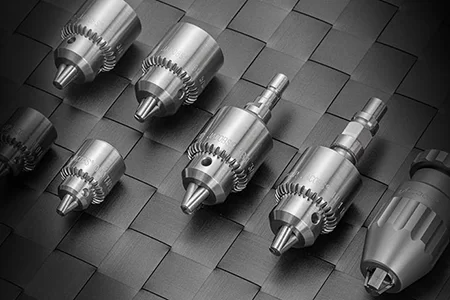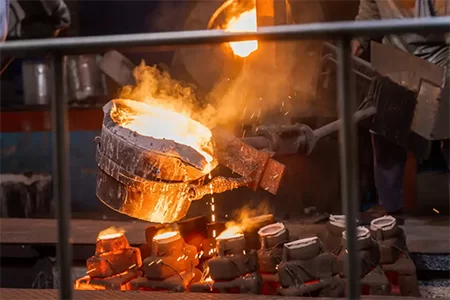
Addressing Defects in Castings - A Comprehensive Guide
-
Home>
-
Blog>
-
Technology>
Addressing Defects in Castings: A Comprehensive Guide
Casting is a widely used manufacturing process that involves pouring molten metal into a mold cavity and allowing it to solidify. It offers numerous advantages, such as the ability to create complex shapes, high production rates, and cost-effectiveness. However, despite its many benefits, casting can also be plagued by various defects that can compromise the quality, performance, and safety of the final product. Defects in castings can lead to costly rework, production delays, and even customer dissatisfaction. Therefore, it is crucial for manufacturers to understand the common causes of casting defects and implement effective strategies to prevent and address them.
Understanding Casting Defects
Casting defects can occur at any stage of the casting process, from the design and preparation of the mold to the pouring and solidification of the molten metal. These defects can take many forms, each with its own unique characteristics and causes. Some of the most common casting defects include:

Porosity
Porosity is the presence of small holes or voids within the casting. It is one of the most prevalent defects and can significantly affect the mechanical properties and surface finish of the part. Porosity can result from shrinkage during solidification, gas entrapment, or the presence of impurities in the metal.
Shrinkage Porosity: This occurs when the metal contracts as it solidifies, creating areas of low pressure that draw in surrounding liquid metal. Inadequate gating and riser design can exacerbate shrinkage porosity.
Gas Porosity: Gas porosity is caused by the entrapment of gases, such as hydrogen or nitrogen, within the metal during solidification. This can be due to improper degassing of the melt, contamination, or poor venting of the mold.
Dross Porosity: Dross, which consists of impurities such as oxides and slag, can float to the surface of the molten metal and get trapped within the casting.
Inclusions
Inclusions are non-metallic particles or substances that are trapped within the casting. These can originate from various sources, including the metal itself, the molding materials, or the environment. Inclusions can weaken the casting and lead to cracking or other forms of mechanical failure.
Metallic Inclusions: These are typically fragments of non-metallic phases or intermetallic compounds that form during the melting process or within the molten metal.
Exogenous Inclusions: These are impurities introduced from outside the metal, such as sand, refractory materials, or other debris from the mold or furnace.
Cracks and Fractures
Cracks and fractures are serious defects that can render a casting unusable. They can occur due to excessive thermal stresses, inadequate geometry, or improper handling during the casting process.
Hot Tears: These are cracks that form during the solidification stage due to thermal stresses and shrinkage. Insufficient feeding or improper mold design can contribute to hot tears.
Cold Cracks: These cracks develop after the casting has fully solidified, usually due to residual stresses. Factors such as poor design, rapid cooling, or high carbon content can increase the likelihood of cold cracks.
Mismatch and Warping
Mismatch and warping refer to dimensional inaccuracies and distortions in the casting. These defects can occur due to uneven cooling, differential shrinkage, or improper alignment of the mold halves.
Mismatch: This occurs when the two halves of a mold are not properly aligned, resulting in a misaligned casting.
Warping: Warping is the bending or twisting of the casting due to uneven cooling or differential shrinkage. This can be exacerbated by non-uniform cross-sections or insufficient restraint during cooling.
Surface Defects
Surface defects can affect the appearance and quality of the casting. Common surface defects include:
Cold Shut: This occurs when two streams of molten metal meet and fail to fuse properly, creating a line or seam on the surface.
Scabs: Scabs are rough, irregular patches on the surface of the casting that can result from metal splashing, mold erosion, or inclusions.
Sand Holes: These are small holes on the surface of the casting caused by sand particles being washed into the molten metal.
Causes of Casting Defects
Understanding the root causes of casting defects is essential for implementing effective prevention and mitigation strategies. Some of the most common causes of casting defects include:
Mold Design and Preparation
The design and preparation of the mold play a critical role in determining the quality of the casting. Poor mold design can lead to issues such as improper feeding, inadequate venting, and uneven cooling, which can result in defects.
Gating System Design: The gating system controls the flow of molten metal into the mold. Improper design can lead to turbulence, air entrapment, and insufficient feeding, resulting in defects such as porosity and inclusions.
Riser Design: Risers are used to supply additional molten metal to compensate for shrinkage. Improper riser size, placement, or number can lead to incomplete feeding and solidification defects.
Mold Venting: Inadequate venting can lead to the entrapment of gases, resulting in gas porosity. Proper venting is essential to prevent this defect.
Mold Material Selection: The choice of mold material can affect the quality of the casting. For example, using a mold material that is incompatible with the molten metal can lead to inclusions or reaction with the metal.
Melting and Pouring Process
The melting and pouring process is another critical stage that can impact the quality of the casting. Various factors can contribute to defects during this stage:
Melting Temperature: Melting the metal at incorrect temperatures can lead to incomplete melting, inclusions, or excessive gas evolution.
Pouring Temperature: Pouring the molten metal at the wrong temperature can result in cold shuts, misruns, or other defects.
Pouring Speed: The speed at which the molten metal is poured can affect the filling of the mold cavity. Too fast or too slow pouring can lead to defects such as porosity, inclusions, or mismatch.
Metal Purity: Impurities in the molten metal can lead to inclusions, porosity, or other defects. Proper degassing and purification are essential to minimize these issues.
Cooling and Solidification
The cooling and solidification process is crucial in determining the final structure and properties of the casting. Improper cooling can result in defects such as porosity, cracks, and warping.
Cooling Rate: The rate at which the casting cools can affect the formation of microstructures and the distribution of stresses. Rapid cooling can lead to thermal stresses and cracking, while slow cooling can result in coarse grain structures and poor mechanical properties.
Solidification Sequence: The sequence in which different regions of the casting solidify can impact the feeding and shrinkage behavior. Proper control of the solidification sequence is essential to prevent shrinkage defects.
Residual Stresses: Residual stresses can develop during cooling and solidification, leading to warping or cracking. Stress-relief treatments, such as annealing, can help mitigate these issues.
Mold and Core Materials
The materials used for the mold and core can significantly impact the quality of the casting. Factors such as permeability, thermal conductivity, and chemical compatibility play a role in determining the likelihood of defects.
Mold Permeability: The ability of the mold material to allow gases to escape is critical in preventing gas porosity. High-permeability mold materials are preferable in many cases.
Thermal Conductivity: The thermal conductivity of the mold material affects the cooling rate of the casting. Materials with appropriate thermal conductivity can help achieve uniform cooling and reduce the risk of defects.
Chemical Compatibility: The chemical compatibility between the mold material and the molten metal is essential to prevent reactions that can lead to inclusions or other defects.
Prevention and Mitigation Strategies
Preventing and mitigating casting defects requires a comprehensive approach that addresses each stage of the casting process. Below are some effective strategies for minimizing the occurrence of defects:
Optimize Mold Design
Proper mold design is crucial for producing high-quality castings. Key considerations include:
Gating System Optimization: Design a gating system that ensures smooth, turbulent-free flow of molten metal into the mold cavity. Use appropriate cross-sectional areas, taper angles, and gate locations to minimize turbulence and promote even filling.
Riser Design and Placement: Design risers that are properly sized and positioned to provide sufficient feeding during solidification. Consider using insulating or exothermic risers to control solidification and feeding.
Ventilation: Incorporate adequate venting to prevent gas entrapment. Use vents of appropriate size and placement to allow gases to escape from the mold cavity.
Mold Material Selection: Choose mold materials that are compatible with the molten metal and provide the desired properties, such as permeability, thermal conductivity, and dimensional stability.
Control Melting and Pouring Processes
Proper control of the melting and pouring processes is essential to prevent defects:
Temperature Control: Maintain precise control over melting and pouring temperatures to ensure proper fluidity, minimize inclusions, and prevent cold shuts or misruns.
Pouring Speed: Adjust the pouring speed to match the mold filling requirements and minimize turbulence. Avoid pouring too fast, which can lead to inclusions, or too slow, which can result in incomplete filling.
Metal Purity: Use high-purity raw materials and implement effective degassing and purification techniques to minimize impurities and inclusions in the molten metal.
Manage Cooling and Solidification
Effective management of the cooling and solidification process helps prevent defects:
Controlled Cooling Rates: Achieve controlled cooling rates to minimize thermal stresses and promote uniform solidification. Use cooling media, such as air, water, or oil, and implement chills or insulators as needed.
Solidification Sequence Optimization: Design the mold to control the sequence of solidification and ensure proper feeding and shrinkage behavior. Position risers and gates strategically to minimize shrinkage porosity.
Residual Stress Management: Implement stress-relief treatments, such as annealing or normalizing, to reduce residual stresses and prevent warping or cracking.
Ensure Mold and Core Quality
High-quality mold and core materials are essential for producing defect-free castings:
Mold Material Selection: Choose mold materials that are appropriate for the specific casting process and metal. Consider factors such as permeability, thermal conductivity, and dimensional stability.
Core Design and Manufacture: Design cores that are easy to manufacture and assemble while providing the necessary support and accuracy. Use core materials with appropriate properties and ensure proper venting and gating.
Mold Maintenance: Regularly inspect and maintain molds to prevent wear and tear that can lead to defects. Clean molds thoroughly between uses and apply appropriate coatings or treatments to enhance performance.
Case Studies
To illustrate the practical applications of casting defect prevention and mitigation strategies, let us examine a few case studies from the industry.
Case Study 1: Automotive Casting Defects
A leading automotive manufacturer was experiencing high rates of porosity and inclusions in its aluminum engine blocks. After a thorough investigation, it was determined that the defects were primarily caused by poor gating and riser design, as well as inadequate degassing of the molten metal.
To address these issues, the manufacturer optimized the gating system to promote smooth flow and minimize turbulence. It also redesigned the risers to provide better feeding and solidification control. Additionally, the company implemented advanced degassing techniques to reduce impurities in the molten metal. As a result, the incidence of porosity and inclusions decreased significantly, leading to improved casting quality and reduced production costs.
Case Study 2: Aerospace Casting Cracks
An aerospace company was facing challenges with cold cracks in its titanium alloy turbine blades. The cracks were causing premature failures and were a major safety concern.
After analyzing the problem, it was determined that the cracks were due to excessive thermal stresses during cooling and solidification. The company addressed this issue by implementing a stress-relief treatment after casting, which involved heat treatment to reduce residual stresses. It also optimized the cooling process to achieve more uniform cooling rates. These measures successfully eliminated the cold cracks, improving the reliability and performance of the turbine blades.
Case Study 3: Heavy Machinery Casting Warping
A heavy machinery manufacturer was experiencing warping in its cast steel components, leading to dimensional inaccuracies and assembly issues.
Upon investigation, it was found that the warping was caused by non-uniform cooling and differential shrinkage during solidification. The company redesigned the mold to improve heat distribution and control the cooling rate. It also used chills to accelerate cooling in specific areas and implemented stress-relief treatments after casting. These changes resulted in reduced warping and improved dimensional accuracy of the components, enhancing overall product quality.
Conclusion
Casting defects pose significant challenges to manufacturers, impacting product quality, performance, and safety. By understanding the common causes of casting defects and implementing effective prevention and mitigation strategies, manufacturers can significantly improve casting quality and reduce production costs.
As a professional casting foundry, Hulk Metal is also constantly learning about new advances in casting defect prevention and mitigation, hoping to further improve casting quality and efficiency. The battle against casting defects is a complex but winnable battle. As long as we are committed to quality and uphold the spirit of continuous improvement, overcome any obstacles, and believe that our efforts will be reflected in the excellence of our products and the satisfaction of our customers in the future. If you also have any questions about castings, please feel free to discuss with us.
Article Navigation
Article Navigation
Industries
Foundries
-

March.18, 2025
Surface Roughness Comparison of Castings with Different Materials and Processes
READ MORE
-

March.12, 2025
Applications of Stainless Steel Castings in Medical Devices
READ MORE
-

March.10, 2025
Achieving Precision in Metal Casting: Key Strategies for High-Quality Casting Parts
READ MORE
-

February.25, 2025
How to Compare Product Quality Between Different Casting Foundries?
READ MORE
-

February.14, 2025
What Are The Metal Casting Materials Commonly Used in Foundries?
READ MORE
-

November.18, 2024
What Should Casting Manufacturers Pay Attention to in Production Management?
READ MORE








